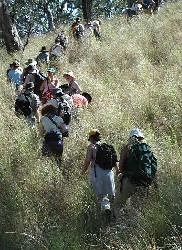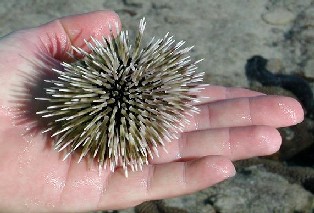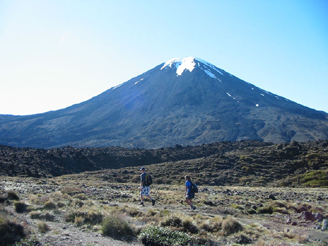
Queensland Term Abroad
Classes
The academic program consists of four classes:While in Brisbane, students will attend mandatory daily course sessions with short breaks in between class times. Classes will consist of lectures and discussions. Formal classroom work alternates with fieldtrips.

Students on an excursion
The Terrestrial Ecology of Australia - Examines the heritage of the terrestrial flora and fauna of Australia, and assumes a basic familiarity with the biology and ecology of terrestrial systems. The origins and uniqueness of Australia's flora and fauna will be discussed in light of continental drift, past and present Australian environments. The course combines lectures and field-based work with essays and research reports to develop knowledge of Australia's unique terrestrial environments and to provide the skills with which to investigate them. Field activities include a half day field excursion during the first week of the program in a eucalypt forest, five days on Stradbroke Island (a large sand island bearing mainly wallum vegetation, jointly with the Marine Biology Program), and five days in rainforest at Lamington National Park. Toward the end of the program, a week in an arid inland site gives students further opportunity to examine and explore aspects of terrestrial ecology shaped by the harsh environment.

Marine ecology up close: a sea urchin
The Marine Ecology of Australia - Assumes some familiarity with biological and ecological principles, sampling techniques, sampling and experimental design and statistics. The course draws together background knowledge of Australian marine systems and maritime resources with a variety of concepts and exercises in marine biology. The program takes participants from the rich diversity of the estuarine and coastal systems around Moreton Bay to Lady Elliot Island on the Great Barrier Reef. It combines classroom lectures and field-based learning with essays and research reports to provide an understanding of tropical marine biology and ecology.

Mt Nguaruhoe (LOTR's Mt Doom)
in New Zealand
Geology of Australia and New Zealand - Assumes a basic understanding of scientific concepts and is offered concurrently with Terrestrial Ecology and Marine Biology. This course investigates the plate tectonic evolution of Australia and New Zealand from the breakup of Gondwana to the modern setting. This tectonic evolution is largely responsible for the unique flora and fauna of both landmasses, and in this sense, the geology is a common foundation for all three courses. After a tectonic overview, the course focuses first on the evolution of passive margins and then on active margins. The first section is on the evolution of a rifted passive margin and the stratigraphic and sedimentologic aspects of these margins with a focus on eastern Australia and eastern North America. Here we are concerned with passive margin thermal subsidence and the resulting mature sedimentary sequences that develop on slowly subsiding margins, including barrier islands and carbonate reefs. The second part of the course looks at the volcanic and seismic hazards of an active margin, as illustrated by the geology of New Zealand. Here we focus on the plate tectonic setting of subduction and strike slip margins. The hazards on such margins include volcanic eruption of basaltic, andesitic, and rhyolitic centers, all of which are active on the North Island and on the west coast of the US. The hazards also include normal, thrust, and strike slip faults that are active along the entire plate boundary. We will investigate the simultaneous occurrence of thrust and normal faults on the North Island, and the spectacular Alpine fault on the South Island. The beginning of the course is in New York where we focus on the local stratigraphic section, which shows the transition from a passive margin to an active margin in the lower Paleozoic.

Rock Art on Mt. Moffat
Australian Culture, Society, and Contemporary Issues - Draws upon the expertise of lecturers from a number of departments and programs (especially the Australian Studies Program and the Aboriginal and Torres Strait Islander Studies Program) at the University of Queensland, as well as practitioners from a variety of fields. Among the topics that may be covered are: Aboriginal society and culture; European impact on the environment; sustainable agriculture and development; the Australian political system; the economy of Australia; health care and education; and nuclear weapons in the South Pacific. Discussions, journals, papers, and student presentations will provide a chance for reflection on the similarities and differences between the cultures of Australia and the United States.